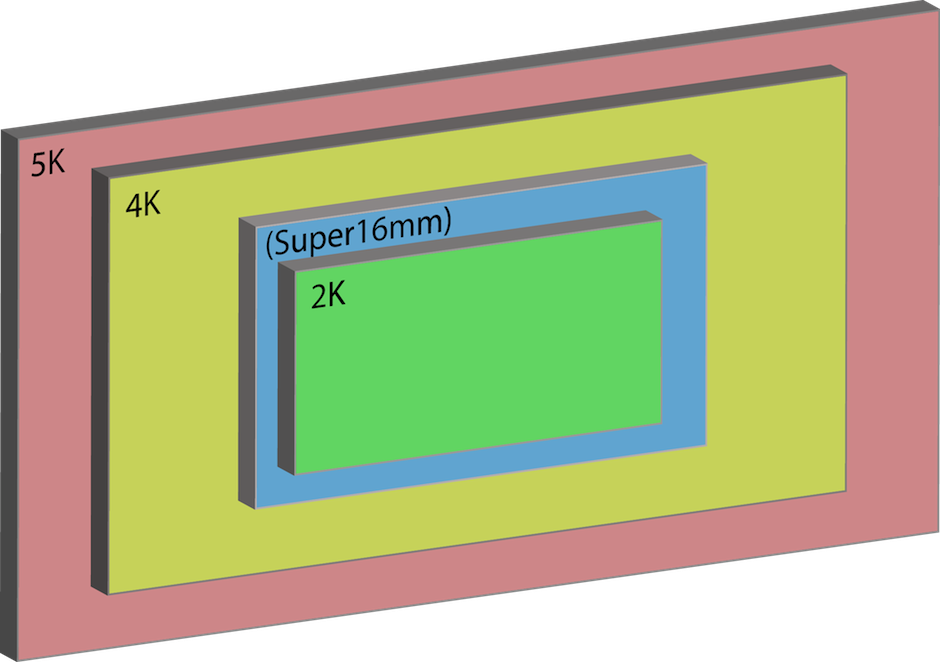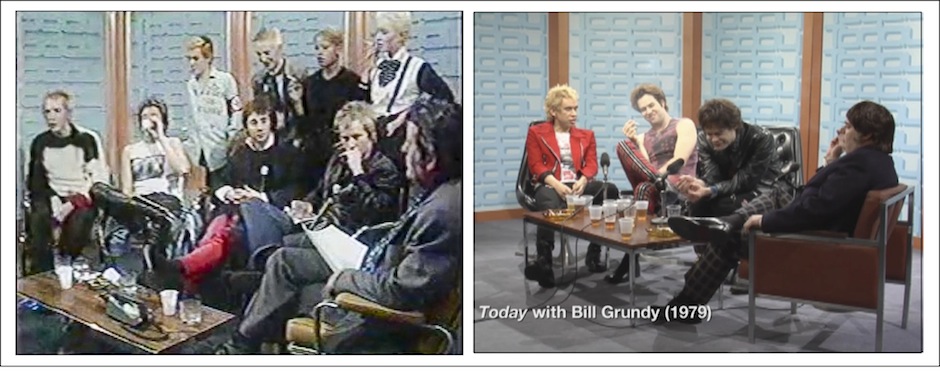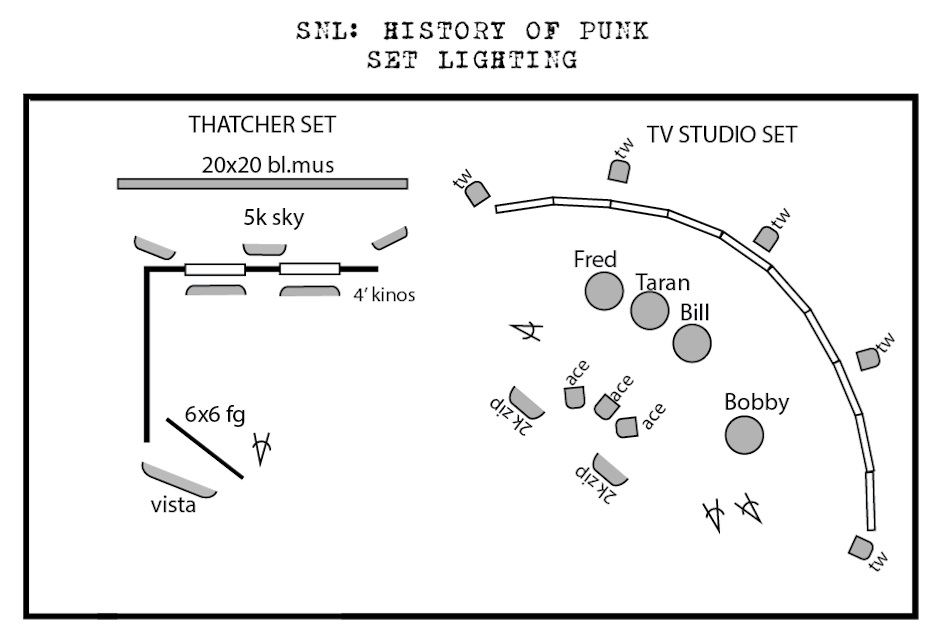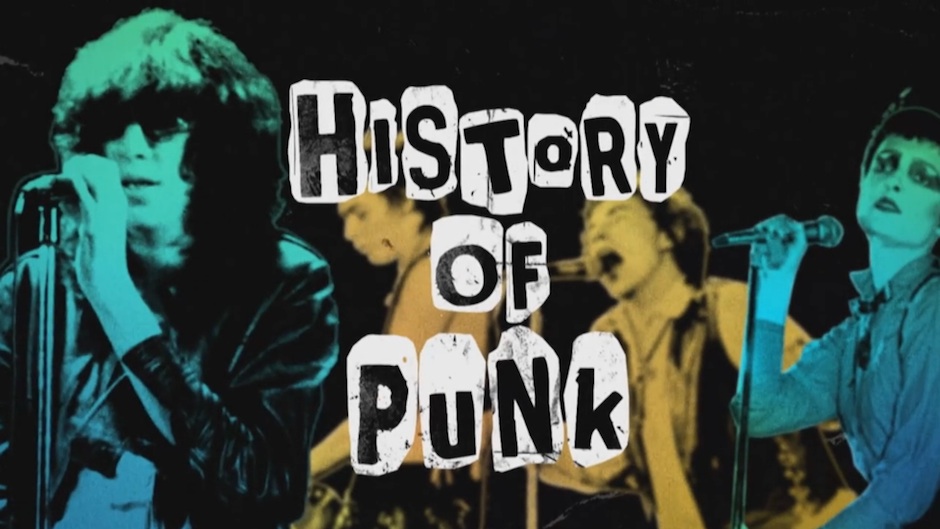This post is the first installment in a series I’m simply calling HOW WE DID IT where I’ll tell the behind-the-scenes story of one my shoots. The shoot may be an SNL short, a real commercial, a feature film or even a documentary. In this case, I’m writing about this weekend’s SNL Film Unit spot, “History of Punk”.
For starters, let’s talk about the weekly schedule at SNL. The writers and cast members have to reinvent the show every week with new material, leading up to a table reading on Wednesday afternoon. By Wednesday evening, a dozen or so sketches will be chosen for the show that week and that’s when the Film Unit director/producer Rhys Thomas gets the green light for the film piece we’re shooting that week. For my part, I’ll receive the script on Wednesday night, at which point I’ll pack my bags and head for the airport. (Believe it or not, I live in LA and commute to NY each show week.) The 11:30pm redeye from LAX to JFK is now a rote part of my weekly existence. I arrive in NYC around 7:45am, grab a quick shower in the Delta SkyClub at the airport – no joke! – and catch a cab to the office where Rhys, our Production Manager, Justus McLarty, and the rest of the team have already started the mad scramble of our single prep day. In general, we prep Thursday and shoot Friday for broadcast on Saturday. I’ll keep mentioning the timeline as I walk through the spot, since the turn-around schedule is by far the biggest pressure we face.
“History of Punk” was actually the second script that we were handed to produce on Friday. The first script was “Al Pacino HBO Biopics” – a tour de force of Bill Hader’s supreme Al Pacino impression, for which we had to create at least 10 different looks on the same courtroom set. That alone would normally be a big challenge so the additional script was a little overwhelming at first. But the “Punk” script was just so good, we were all immediately up for it. The short film is a mockumentary about punk legend Ian Rubbish (Fred Armisen in the mold of Johnny Rotten), who parted ways with his band The Bizzaros (Bill Hader and Taran Killam) over his controversial support of Margaret Thatcher. Written by Fred Armisen and Seth Meyers in the wake of Margaret Thatcher’s death last week, the script is about the coolest and classiest tribute I can imagine. For me it was extra fun because I also make documentary films when I’m not working for SNL, so making a “Spinal Tap”-style mockumentary is completely up my alley.
The biggest challenge of this spot was trying to figure out how we were going to accomplish so many different dated looks and sets in our incredibly short timeframe. There were multiple period punk concerts, still photo montages, modern day interviews, a setup at 10 Downing Street with Margaret Thatcher and a recreation of the infamous 1976 Bill Grundy interview with the Sex Pistols… Schedule-wise, we’d start Friday morning with the “Punk” spot, but “Pacino” was also huge so we thought we’d have to finish shooting EVERYTHING on “Punk” by midday. At first glance I thought there’s just no way – it’s an 11-page short film!
The first decision was to shoot the concert footage on Thursday night – the day of our prep. This was risky since we were prepping two jobs at once, so throwing in a shoot as well meant losing prep time for both spots. But we quickly decided it was the only solution. Rhys suggested a bar on the Lower East Side called Arlene’s Grocery – we didn’t even have time to scout it — and they agreed we could show up at 5pm but had to be gone by 7pm. 2 hours? Uh…okay – I guess we can do that.
The next question was camera formats. We looked at a lot of Sex Pistols concert footage along with clips from their documentary, “The Filth and the Fury”. Right away we knew we wanted a grungy 16mm handheld look, with hard contrasty lighting and strong primary colors that screamed that late 70s period. We certainly weren’t going to shoot with an actual 16mm camera – no time for processing on this schedule and I don’t think there’s even a lab in New York that still processes 16mm. My first thought was to use a 4/3” sensor camera like the Black Magic, with some beat-up old 16mm lenses. But I’ve never worked with the BMCC and this didn’t seem like the right job to throw a new workflow into the mix, so I decided to use an Epic, windowing the sensor down to 2K. red cloud One of the unique things about the Epic is the way it changes the active sensor size and crop factor when you change resolutions. I normally find this a tad annoying, but in this case I figured that the smaller sensor size would give me the appropriate depth of field for a 16mm look. I also boosted the ISO to 1600 to pickup a little extra noise.

Red Epic sensor formats compared to Super16mm
Next up I had to decide on glass. I wanted old 16mm lenses to give me a flare-y, slightly soft image and circa 1977 look. Our rental house on this job was TCS, where my longtime 1st AC, Nick Demas, found an old Cooke 9-50mm zoom that sounded great, along with a set of old Canon K35 primes: 18mm, 24mm, 35mm, 55mm, 85mm. The K35’s are the perfect era but they’re 35mm lenses so on the Epic’s 2K sensor, they’d effectively double in focal length, which would be way too long. I went with the old 16mm zoom that fit the sensor’s target size much closer and it looked AMAZING. It was pretty fast for a zoom (T2.5) and I could manually snap the zoom with one hand. It gave us huge flares and natural softness, and the 9mm focal length was ideal for the look.
In addition to the “fake 16mm-Epic”, we did the unthinkable and shot some footage with…an iPhone! Rhys has an iPhone 5 with the 8mm app by Nexvio, so this B-camera rental cost us a whopping $1.99! Totally absurd, but it looked shockingly good. I’ve had the app on my phone for a while and goofed around with it a bit but never considered it for a professional shoot until I heard that some of the scenes in this year’s Oscar-winning documentary “Searching for Sugar Man” were shot with the app after the director ran out of money and had to finish his film somehow. I would have never guessed. (That’s an amazing doc, by the way – well worth your time!)
We also wanted to shoot still photos to further drive the documentary style, so after covering a song with the Epic, we’d then do it again with a 5DmIII with an L-series 50mm. I was amazed out how well those shots fell right into place – mostly due to how perfect Fred, Bill and Taran looked in those costumes and hair & makeup. I have long believed that the most impressive thing about SNL is the hair & makeup team. What they accomplish in the time they’re given is pure magic. Hair, makeup and wardrobe are departments that often seem to get short changed as the lion’s share of credit for the “look” of a spot goes to the camera and lighting departments, but if you want a great look, don’t make the mistake of overlooking “the vanities”. In this case, those unsung heroes are: Jodi Mancuso and Alison Wadsworth in Hair & Makeup (respectively), Brian Hemesath in Costumes and Munee Hayes in Wardrobe.
I also want to note that Fred, Bill and Taran are actually playing those songs live. We didn’t have time to pre-record those tracks and shoot music video style. I knew that Fred had spent years as a drummer in a real punk band back in the late 80s/early 90s and SNL sometimes finds a way to showcase his legit musical skills, but I had no idea that Bill and Taran could also play. Seth wrote the lyrics to the songs and Fred even recorded a full-length version of “Hey Maggie Thatcher”. UPDATE: YOU CAN KNOW DOWNLOAD FULL VERSIONS OF IAN RUBBISH SONGS AT www.ianrubbish.com.
Next up we had to figure out how to recreate the “Bill Grundy” TV interview look. My father-in-law is a former live-television director so I showed him the Grundy/Sex Pistols clip and asked him what kind of camera they were likely using. He knew that ITV produced the show and they would have been using PYE studio video cameras. Look it up – they’re hilariously enormous. For our purposes, my new goal was to find a sufficiently dated standard def video camera that we could push further in post – maybe we’d dub the footage to VHS and then re-ingest to get that signature degraded-tape archival look. It soon became clear just how far we’ve all come from the SD world. The last thing we wanted to deal with on the post end was some archaic tape format – let alone try to source something like BetaSP stock! I ended up deciding that my old faithful Panasonic HVX200 in SD mode would do the trick. I spent three years shooting my documentary, “Bigger Stronger Faster” with an HVX200 and I know that camera inside and out – I was totally comfortable that it would give us a sufficiently dated SD look. I also can’t stress enough how great it is to work with a director like Rhys at a place like SNL where they’re totally game for broadcasting clips in 4:3 aspect ratio to get the right look – I know plenty of other shows would have insisted on 16:9 for everything regardless.
By far, the secret weapon for the look of the TV interview set is our Art Director, Andrea Purcigliotti. She created an exact replica of the Grundy set, printed out on gator board, which she then setup in a half-dome with those perfect period chairs and props. All I had to do was add a bunch of hard fresnel light to emulate the period TV-lighting style. We used a half dozen Tweenies as backlights and rigged four 1k-Baby fresnels on a pipe over the set as the keys, along with a couple of old-school 2k zip soft lights bashing from the front. We setup three HVX200 cameras in SD mode and it all just fell into place. We did very little post processing. We planned on further degrading the footage through a VHS or Beta deck but soon realized we didn’t really need it.

The 1976 Bill Grundy interview with The Sex Pistols compared to the SNL recreation of the Grundy set
For the Margaret Thatcher set, we went back to the fake-16mm Epic look. The set was a little two-wall living room with two large windows – based on some photos that Rhys had pulled of Margaret Thatcher publicity photos. My Key Grip, Mort Korn, hung a 20’x20’ bleached muslin outside the set that my Gaffer, Sean Sheridan, lit it up with three 5k skypans to blow out the windows, and we also skinned the windows with opal diffusion to make sure you couldn’t see any detail through the sheer curtains. We hung a 4’ 4-bank Kino over each window to carry the window light into the room and then used an Image80 Kino through a 6’x6’ Full Grid as the key. find domain owners . No fill light – I brought in a 12’x12’ solid as negative fill to create a more “real” contrasty look.

Finally we had to shoot the modern-day interviews. We set up the Bill Hader interview in the upstairs loft of the soundstage – which happened to look amazing with a ton of natural light and really great exposed beams & bricks. We were going for a stark, very filmic, sorta old-school BBC-style doc look, so we dragged our Image80 and 6’x6’ Full Grid upstairs and went with the natural feeling of the room, lighting for a soft window-lit but contrasty interview. Camera-wise, we used the same Epic but went back to a normal 4k sensor size and I upgraded to my favorite Leica Summilux primes, shooting wide-open on a 50mm and a 100mm, which – at ISO800 – required an ND9. I also used a diffusion filter to slightly soften the image. I like both Tiffen SoftFX and Pancro Mitchell diffusion. Mitchell is definitely more old school so I felt that was appropriate – using a Mitchell A. I certainly don’t think the Leica lenses need diffusion but sometimes a little diffusion is helpful when dealing with wigs and ageing makeup. We shot another interview on the Margaret Thatcher set, but shooting on the opposite wall, avoiding the windows, so it looked like a completely different environment.
Right about then we got word that Fred Armisen had reached out to THE Steve Jones from the Sex Pistols – who said he’d be happy to record a line for the spot. Problem is: he lives in Beverly Hills! It was 3pm by this point and I scrambled to find a shooter in LA who could jump on this. Luckily my friend Jon Carr answered the call and was willing to drop whatever he was doing and race over to Steve Jones’ house with his Epic and a LightPanel. He shot the interview, uploaded the footage to DropBox and we were looking at it onset before the end of the day – amazing.
By this point, we were deep into lighting the “Pacino” spot, yet still had a few other interviews to shoot for “Punk”. We briefly considered shooting them on Saturday morning but that was sounding crazy even to us. So we reached out to DP Jason Vandermeer, who was just wrapping another SNL shoot with an Alexa package. He had a set of Cooke S4s, which I thought would be a decent match to the look of the Leica lenses, so I sent him still frames of our setups along with our focal lengths and basic lighting strategy and he picked up the remaining interviews back at 30 Rock.
On the post-side, Rhys and editor Alex Serpico hammered this out in one long 14-hour session starting Saturday morning. Most of the footage was already sufficiently beat-up and didn’t require a ton of manipulation. The only footage that we had graded is the modern day interview footage. I asked our colorist, Emery Wells at Katabatic, to take the edge off the modern look and give it a filmy-feeling, which he created with a slight desaturation, a rounded-rectangle vignette to emulate a film gate and then layering the color into the image to give it depth by setting explicit qualifiers for the shadows, mids and highlights separately. In Emery’s words: “Even though a 3-way color corrector is split into shadows, mids and highlights by default, images are never exposed in such a perfectly ideal distribution. So I split the image up into my own luma ranges based on how it was exposed and then use the shadows, mids and highlight controls on the board within each my qualifiers. That essentially gives me nine levels of control.”
SNL is a pretty special place to work and as you may have guessed, it’s impossible to accurately convey how it all really happens; my goal with this blog is simply to translate some of the lessons that I learn each week – often by trial-and-error – into practical advice for whatever you’re shooting. I’ll write a new HOW WE DID IT article for the prior’s week’s spot, “Bathroom Businessman” and post it later this week.
Finally, if you’re interested in learning A LOT MORE about how I like to work, check out my workshop tour this summer. It’s called the VISUAL STORYTELLING TOUR and I’ll be visiting 31 cities across America between June and July. Tickets go on sale this week!

